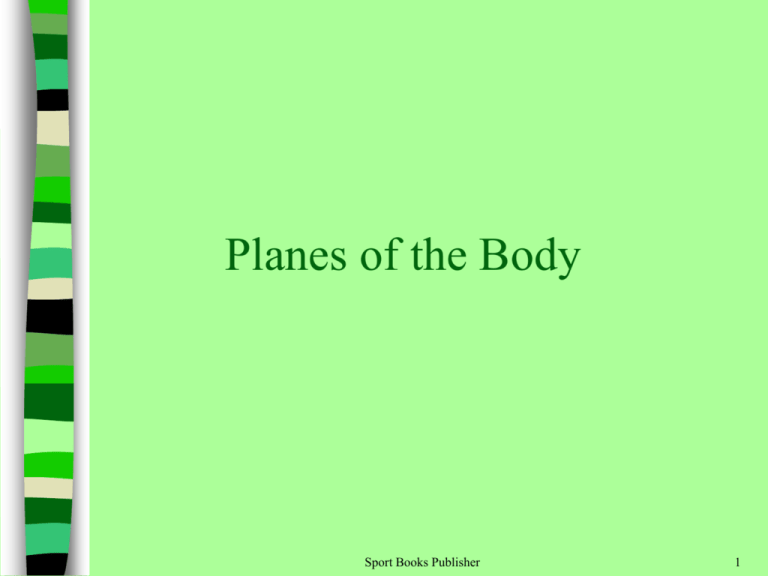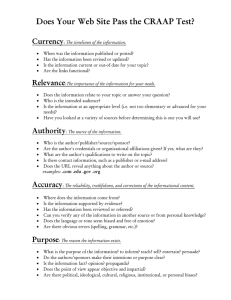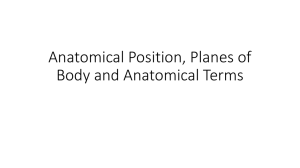2 Planes and Movement terminology
advertisement

Planes of the Body Sport Books Publisher 1 Planes Are imaginary flat surfaces that divide human body They are used to: – – Divide the body for further identification of particular areas Describe different movements or actions Always refer to the body in the anatomical position Sport Books Publisher 2 Median Plane Median plane or midsagittal plane – A vertical plane that bisects the body into right and left halves – Sagittal plane is any plane parallel to the median plane Sport Books Publisher 3 Coronal plane or frontal plane Coronal Plane – A vertical plane that bisects the body into front and back – It is at right angles to the median plane Sport Books Publisher 4 Transverse plane or horizontal plane – A horizontal plane that bisects the body into top and bottom – It’s at right angles to both the median and coronal planes Sport Books Publisher Transverse Plane 5 Centre of gravity – The point at which the medial, frontal, and transverse planes intersect Sport Books Publisher 6 Movements Sport Books Publisher 7 Movement around a joint may be around any one (or more) of three axes Y X Z Most movements are found in pairs - for every movement, there is generally a movement that is opposite to it Sport Books Publisher 8 Flexion-Extension Flexion - reduces the angle between two bones at a joint Extension - increases the angle between two bones at a joint Flexion Usually a sagittal plane movement E.g., Biceps curl – Lifting the weight reduces the angle at the joint = flexion – Lowering the weight increases the angle at the join = extension Extension Sport Books Publisher 9 Dorsiflexion-Plantar flexion Modified flexion with respect to ankle joint Dorsiflexion - bringing the top of the foot toward the lower leg or shin Dorsiflexion Plantar flexion - “planting” the foot Plantar Flexion Sport Books Publisher 10 Abduction-Adduction Abduction – moving a segment away from the midline Adduction – moving segment towards the midline of the body Abduction Frontal plane movement E.g., The motions of the arms and legs during a jumping jack Hint: – Abduct = “take away” from the midline – Adduct = “add” towards the midline Sport Books Publisher Adduction 11 Circumduction A cone of movement that does not include any rotation Occurs when flexion-extension movements are combined with abduction-adduction movements E.g. Tracing an imaginary circle in the air with your index finger – The tip of your finger represents the base of the cone, while your knuckle forms the apex of this conical motion Sport Books Publisher 12 Rotation Turning of a bone on its longitudinal axis Medial rotation - rotation towards the midline Lateral rotation - rotation away from the midline Sport Books Publisher 13 Pronation-supination Movements relative to the forearm and hand Pronation - when the palm is moved to face posteriorly Supination - when the palm is moved to face anteriorly (hint: you can hold a bowl of soup) Pronation Supination Sport Books Publisher 14 Inversion-Eversion Movements relative to the sole of the foot Inversion - When the sole is turned inward (as when you "go over" on your ankle) Inversion Eversion - When the sole is turned outward or away from the median plane of the body Eversion Sport Books Publisher 15







